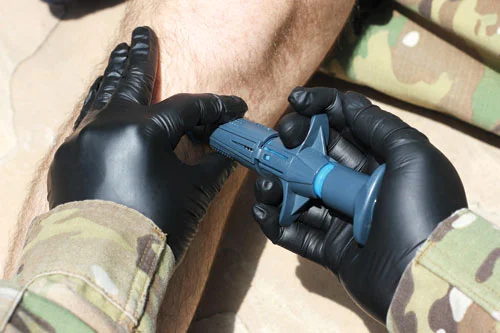EMS Grand Rounds Journal Club: Comparison of Two Intraosseous Devices: The NIO Versus the EZ-IO by Novice Users- A Randomized Cross Over Trial
Article review by Jeremiah Phelps, MD, PhD
Comparison of Two Intraosseous Devices: The NIO Versus the EZ-IO by Novice Users- A Randomized Cross Over Trial
Avi Shina MD, MHA, Erez Nissim Baruch MD, Amir Shlaifer MD, MHA, Ami Shovali MD, Moran Levi, Or Yosefy BSc, David Segal MD, Tarif Bader MD, Itai Shavit MD & Avraham Yitzhak MD
To link to this article:http://dx.doi.org/10.1080/10903127.2016.1247201
Review
This study is a comparison of the ability of novice users to gain interosseous (IO) access using 2 different commercial IO devices. The randomized crossover single blinded study evaluated success of IO access between the IO drill Arrow, common in most combat/prehospital/ED settings, and the NIO device, a new spring-loaded mechanism not as readily distributed to military or emergency medical environments. The 50 participants were undergraduate trained members of the Israeli Defense Force studying to be future army physicians; each randomized to either the Arrow drill of NIO device. Participants were given 75 minutes of basic lecture and hands on practice with both devices using a pig model. Following basic instruction, each participant was asked to obtain successful IO access in the model with the IO device to which they were randomize. Each participant then attempted access with the other device. The primary outcome was first attempt success. Secondary outcomes included ease of use and user preference.
Regarding the primary outcome, there was no difference in first attempt success. Each device reached approximately 90% first attempt success rate. Ease of use was similar between devices. Preference for a device was equal between groups.
Each device had failures to deploy with failure attributable to unique features to each mechanism (difficulty in removing Arrow stylet, failure to disarm NIO safety mechanism during engagement with tissue surface)
Overall these data suggest that with minimal training either device can be utilized by most novices to gain IO access. There are peculiarities to each device that may impact first attempt success, but they do not seem to be major stumbling blocks to success.
The obvious limitation here is that access was obtained in the pig model. Cold dead pig legs aren’t equivalent to human anatomy. The flesh between IO and bone was minimal. Additionally, there is no evaluation of the NIO vs IO Arrow at anatomical sites beyond the pig leg. One might appreciate access attempts at the humerus (or whatever is the pig equivalent). Testing conditions were also limited; there were no combative, obtunded patients, no one was shooting at the participants, nor was access was not obtained in the back of a bouncing ambulance.
Ultimately the NIO device clears the hurdle of “Can one stick a pig bone and gain access to the marrow?” More work is needed to evaluate the device in practical settings and in the context of human anatomy. For now, I think I’ll drill.






